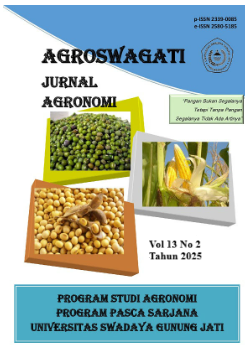PENGARUH BERBAGAI DOSIS PUPUK KANDANG AYAM TERHADAP PERTUMBUHAN DAN HASIL TANAMAN BAWANG DAUN (ALLIUM FISTULOSUM L.)
DOI:
https://doi.org/10.33603/agroswagati.v13i2.11000Abstrak
The objective of this study was to evaluate the effect of different application rates of chicken manure on the growth and yield of Welsh onion (Allium fistulosum L.) cultivar Mani’is. The experiment was conducted in paddy field land located in Babakanmulya Village, Jalaksana District, Kuningan Regency. The research site is characterized by clay loam soil with a pH of 5.78, temperature ranging from 20°C to 27°C, altitude of 654 meters above sea level, air humidity of 80%, annual rainfall of 2,030 mm, and average daily sunlight exposure of 12 hours. The experiment was carried out from April to June 2013. The research employed an experimental method using a Randomized Block Design (RBD) with one treatment factor, namely the application rate of chicken manure consisting of six levels: 0, 4, 8, 12, 16, and 20 tons per hectare. Observed variables included plant height, number of leaves, number of tillers, fresh weight per clump, and fresh weight per plot. The results demonstrated that chicken manure application significantly influenced plant height at 35 and 42 days after planting (DAP), number of leaves at 28 DAP, number of tillers at 28 DAP, fresh weight per clump, and fresh weight per plot. Among the treatments, the application of 12 tons/ha of chicken manure produced the best growth performance, with the tallest plant height reaching 42.5 cm at 35 DAP and 50.5 cm at 42 DAP. This treatment also resulted in the highest fresh weight per plot, averaging 0.8 kg, which was equivalent to the application of 4 tons/ha.
Unduhan
Diterbitkan
Terbitan
Bagian
Lisensi
Hak Cipta (c) 2025 Arief Nuryadin, Dudung Abdurachman, Dodi Dikrurahman

Artikel ini berlisensiCreative Commons Attribution-ShareAlike 4.0 International License.
The Authors submitting a manuscript do so on the understanding that if accepted for publication, copyright of the article shall be assigned to Jurnal AGROSWAGATI, Sekolah Pascasarjana Ilmu Pertanian. Universitas Swadaya Gunung Jati as publisher of the journal. Copyright encompasses rights to reproduce and deliver the article in all form and media, including reprints, photographs, microfilms, and any other similar reproductions, as well as translations.
Jurnal AGROSWAGATI, Universitas Swadaya Gunung Jati and the Editors make every effort to ensure that no wrong or misleading data, opinions or statements be published in the journal. In any way, the contents of the articles and advertisements published in Jurnal AGROSWAGATIare the sole responsibility of their respective authors and advertisers.











